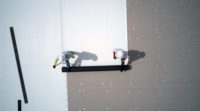Space. The great unknown. Just the thought of it gets the mind wandering. But the reality is that life on other planets might become possible for us in the near future. NASA currently has plans to send a team in the year 2033. One of those people have already been chosen. Seventeen-year-old Alyssa Carson from Baton Rouge, La. is preparing to become one of the first humans ever to step on the mysterious red planet.
Enter NASA’s 3D Printed Habitat Challenge—a multi-phase competition as part of NASA’s Centennial Challenges “to design and build sustainable shelters for humans to live on Mars.” The challenge started in 2014 with Phase One (the initial design using 3D printing) and Phase Two (designing a recycling system that can create structural components using terrestrial and space-based materials.) The competition has finally reached the first level of Phase Three which focuses on fabrication of complete habitats.
Out of 18 total firms that submitted proposals, only five were awarded the cash prize. One of those firms was Detroit, Mich.’s Albert Kahn Associates Inc. Working with W.G. Yates & Sons Construction Co. based in Jackson, Miss., the firms have secured a portion of the $100,000 award ($19,580.97) appointed by NASA and Bradley University of Peoria, Ill.
The first level of Phase Three required the teams to design a 1,000-square-foot living space that would support four astronauts during their one-year stay on Mars. Each of the teams used BIM to design the functional and physical characteristics of their proposed habitats. The design has to combine allowances for both the structure and the systems it must contain.
“We are thrilled to see the success of this diverse group of teams that have approached this competition in their own unique styles,” said Monsi Roman, program manager for the NASA Challenges. “They are not just designing structures, they are designing habitats that will allow our space explorers to live and work on other planets. We are excited to see their designs come to life as the competition moves forward.”
The Design at Hand
Kahn + Yates placed third overall with their proposed design. The concept features a five-axis print arm that extends from the top of a prefabricated core to print the shell using materials gathered from Mars. At the same time, secondary printing nozzles will then make a protective shell using high-density, petroleum-based polyethylene thermoplastic. A portion of the shell will give way to an equipment hatch—allowing for connection of future habitats.
When the shell construction reaches a certain height, supporting structural members and floor plates will deploy from the premanufactured core. As needed, additional slab layers will be created for each floor level desired. Daylight will enter by means of having just the high-density polyethylene layer as the skin and reducing portions of the central concrete layers in the exterior shell. When complete, the pre-manufactured core will contain all of the plumbing, ventilation and life support equipment required.
Creating a habitat such as this is challenging. Think about the limits of not only transporting building materials, but the highly different atmosphere and terrain. This is what led Kahn + Yates to look into developing technologies capable of manufacturing such habitats.
“Part of what we did was assume that technology can catch up with some of the assumptions that we think are within graspable hands right now,” said Anthony Offak, associate, architect and the head of the process for Albert Kahn. “We knew NASA wanted a 3D printed building. So we looked at what is available right now with 3D printing.”
The firm thought in concepts of taking current technologies and what could be within the realm of possibility of someone being able to create within the next five to 10 years. These design aspects will highlight the intricate nature of current 3D printing capabilities. How will this affect the design? How does that affect how certain aspects are not created?
“Currently, there are dual extruder print heads that allow for more than one material to be printed," Offak said. “So that you can be printing your wall and then print a sealant around an opening. That way you have an airtight seal.”
And that’s one of the biggest questions. How can the building industry make an airtight seal with current 3D printing capabilities? For this competition, the teams have to just assume what might be possible. Kahn + Yates figured if they can cut down the number of openings they would need to create—while having hard fast airlocks—then they could limit the amount of depressurization that could potentially occur.
“There is a great breadth in use of technology and 3D-modeling skills among the judges that range from Building Information Modeling software developers to the most sophisticated applications of virtual design and construction,” said Pete Carrato, lead judge and corporate manager of Building Information Modeling at Challenge sponsor Bechtel. “Each team’s submission is a view into the future of developing surface-based facilities on Mars.”
The plan is, of course, for the astronauts to come back. But the reality is that this could end up being a one-way trip. If something goes wrong, it would take at least 8-9 months for another rocket to even get to Mars. Which is why NASA told each team that they wanted at least 48 hours’ worth of redundant air and system backup.
“This stage of the competition asks the participants to design habitats that will combine shelter with critical survival systems,” Roman said. “We are asking them to look beyond the physical structure into the needs of our future explorers.”
Remember the book “The Martian,” by Andy Weir—adapted by 20th Century Fox into a movie of the same title featuring Matt Damon? Kahn + Yates did too which led the teams to include some design aspects that weren’t seen in other proposals. And NASA loved the fact that the teams were pushing boundaries on the design.
“You don't go anywhere without pushing boundaries,” said Offak. “If it's feasible they'll try and do it. We were one of the few teams who thought about putting a garden in, where astronauts could actually grow their own food.”
Offak said the firms also programmed in things like quarantine and emergency showers as well. Turns out, building in space follows a lot of the same ideas we see in the construction industry on a daily basis.
“We were watching a lot of what NASA does and realized all the redundancies they’ve built on everything,” Offak continued. “You can't just design something and say it's going to work perfectly. You have to design something for space and know it's going to fail. On a building water is going to get in. How do you prevent that water from going past a certain point, what do you do with the water once it gets into the exterior wall? So it's similar ideas. Just a different way of looking at it for the specific functions.”
Solving Future Problems Today
They have their work cut out for them. To show that the building can actually be built using a 3D printer, the firms will have to prove that the design's amorphic holes along the outside can be achievable. As of now, the prototype doesn't show these shapes on the outer shell. Kahn + Yates will also have to work with someone who can do finite element analysis (FEA) to determine if the structure is really capable of holding what they think it's capable of holding.
“This level prepares the teams for more difficult levels to come, and they had to do it autonomously, which adds an extra level of difficulty that will be necessary for space exploration,” said Roman. “Each of the skills tested in these levels will come into play for the final competition next spring.”
There are a lot of rule of thumbs with construction on Earth, especially concerning gravity loads. The FEA analysis will show if it can actually work with less gravity. Mars has a third of Earth's gravity and with that comes an unknown type of wind load. They also have to create a 4D animation of how this habitat could get built in real time and show how the constrictions could occur for NASA to get a better understanding of it.
"We've never been to Mars," said Offak. "We don't know what the wind is there other than what NASA predicts. So we have to take a great number of assumptions and do a lot of conservative estimates on it to see if certain things will work."
Another issue that comes into play with a design and environment like this is materials. How do you dig up the local rocks on Mars and create this concrete mixture to be fed into the print arm to print the wall? And at the same time not have the concrete fail or get stuck in the process? It's up to Kahn + Yates to figure out how that can occur. How do you really get into the digging? How do you do the combining? Where’s the water coming from that you're mixing with or are you mixing with something else such as a plasticizer?
As time goes on, and NASA hopes to advance their deep space exploration, reliable habitats such as these will be essential, and these questions will have to be answered. It’s up to our firms on Earth to decide how those should be built and what our future designs can be capable of.
Even on Earth it seems that more and more buildings will eventually start to become 3D printed. It’s up to designers and architects to solve issues when it comes to the combination of printing as well as installing pre manufactured elements within the printing process. Maybe within the next decade we might start to see real buildings get printed. But how do we go about trying to solve the combination of the two elements coming together?
“Maybe we have more items created by just one manufacturer,” Offak said. “Which the owners always like because if something goes wrong it's easier to hammer down one person for that problem versus trying to figure out whose problem it is.”
That’s a trend we see currently in the roofing industry—so we may not be far off. As a whole, we’re excited to see where the future of building takes us. On this planet and on others.
In the next Phase Three level, all the teams will complete their design and show the 4D animation of the various construction phases of their habitats. This is due mid-January 2019 after which NASA will award the top three teams the remaining prize money. Another part of Phase Three, set for April 2019, will have teams 3D print a 1/4 scale version of their habitats. For more information on the Centennial Challenges, visit https://www.nasa.gov/directorates/spacetech/centennial_challenges/index.html or read more about Kahn + Yates’ proposed design at www.albertkahn.com/marschallenge.
Update 10/30/18: The most recent information on the Centennial Challenges can be found here.














